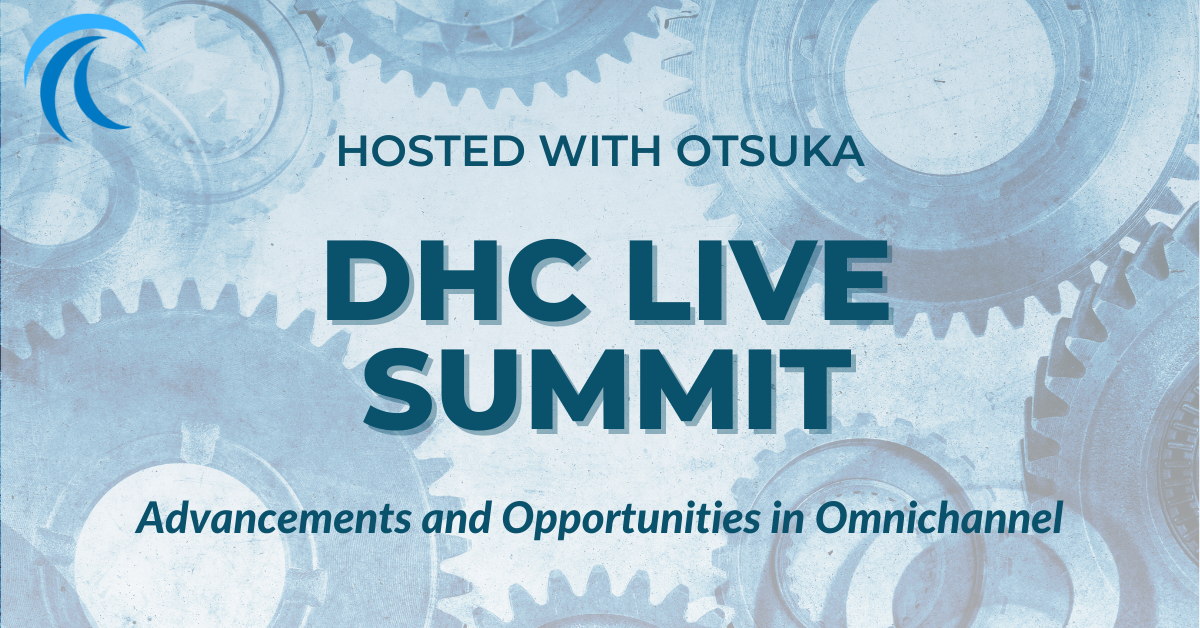Five Things We Learned About Omnichannel Advancements and Opportunities at the dhc Summit
by Christine Franklin, Executive Director, The DHC Group

The latest DHC Summit, with host Otsuka, kicked off with a fireside chat with Otsuka’s Head of Omnichannel COE, Abigail Canlas. An overriding theme throughout the day was that marketers investing their time in omnichannel excellence are motivated by the vision that omnichannel done well can meaningfully impact the patient experience. Ultimately, keeping the patient at the center of your strategy is critical to figuring out how to leverage data, craft excellent creative, and strategically execute omnichannel at scale.
We have put together a list of our top five takeaways from the Advancements and Opportunities in Omnichannel Summit.

Omnichannel requires a willingness not just to “test and learn” but an appetite for risk
NVIDIA CEO and founder Jensen Huang recently said … “Unless you have a tolerance for failure, you will never experiment, and if you don’t ever experiment, you will never innovate. If you don’t innovate, you don’t succeed.”
This sentiment of tolerance for risk was echoed throughout the DHC Summit and analyzed in greater detail by Jim DeLash, Omnichannel Marketing Director, GSK, and Cliff Covey, Senior Vice President, Digital Activation, CMI Media Group. Leaders of organizations interested in seeing omnichannel advance and thrive must create a culture where rapid experimentation is safe and encouraged. Jim DeLash shared the results of a unique challenge he set for his team – running 100 micro-tests in 12 months. In addition to sharing highlights of the tests themselves during an engaging dialogue with DHC Summit attendees, the key takeaway was the necessity for having a shared commitment to curiosity and challenging the status quo. Jim aptly explained, “Don’t assume you know the right answer. Challenge everything that you do.”

Advancing in omnichannel means a better understanding of how to utilize predictive engagement, especially for patients
While pharma has a solid understanding of how to predict behavior and engage with physicians using the right message and channel at the right time, there is likely room for improvement around how brands meet patients along the journey with meaningful messages. Partnering with the right stakeholders can help speed success on that pathway.
In a session led by Sarah Clark, Director, B2B Marketing, Healthline Media, we saw an excellent example of how marketers and brands can capitalize on the strengths of partners to contribute to a patient experience in a meaningful way. Sarah was joined by neurologist Dr. Heidi Moawad, Lisa Denmark, Otsuka’s Associate Director of Omnichannel and Digital Analytics, and Brendan Anderer, SVP of Content at Healthline Media in a discussion of how partners can bring to the table robust first-party data, especially given the ongoing depreciation of cookies. This allows marketers to deliver the right messages to patients and caregivers using first-party data and tailoring that content based on deep knowledge of the audience. Brendan summarized the execution … “We know that we can work with a [pharma] partner to get the messages in front of [the patient/caregiver] because we have that first-party data. We can predict based on the data set that we have what they’re going to do, so we can serve them when they’re in seek mode.”

The content explosion is a by-product of omnichannel
One of the central promises offered by omnichannel evangelists is the ability to leverage modular content in a fast (and compliant) manner. But there’s still much debate around what’s realistic and practical with modular content. This debate was front and center for several of the DHC Summit sessions. In a session with Kevin Rose, Executive Director, Content Excellence, Boehringer Ingelheim and Alexis Cohen, VP, Business Consulting, Global Commercial Content, Veeva, the role of content as the foundation for omnichannel excellence was discussed. The critical first step – know why you want to use modular content. Reasons are varied and may include cost savings, creating content faster, global brand consistency, or delivering a more personalized customer experience. For Kevin Rose, it’s the latter “It should be about the customer. It should be about what resonates for them, and really where you can have the biggest impact with your engagements.”
In a following panel led by Aaron Uydess, EVP, EVERSANA ORCHESTRATE, Solutions & Success, EVERSANA, Kevin Rose was joined by Kristen Vayda-Dreitlein, Omnichannel Brand Lead, Type 1 Diabetes, and Gina Vetsea PharmD, Head, US Regulatory Affairs Advertising & Promotion, both from Sanofi. These stakeholders helped to put a finer point on both the perceived value of modular content (efficiency, consistency etc) as well as how to achieve successful collaboration with MLR in order to go from concept to reality. Enter AI. The panel discussed how it might be possible to use AI innovations to reduce the burden on MLR, generate comfort with reviews, unify global content, and enable content automation. Yet the role of the marketer will remain critical in balancing the what’s possible (creating massive volume of usable content) with what’s best (using data to identify what makes the highest impact and focusing there).

Content analysis is knowing how well your target audience is engaging with your content - a crucial metric in defending and expanding omnichannel
Summit attendees were treated to a master’s class in omnichannel HCP activation that allowed participants to dig into what it looks like to understand how physicians engage with content and what to do next. Led by George Griffith, EVP, Omnichannel Strategy of Relevate Health and Kelli Smith, Associate Director, Nephrology Marketing of Otsuka, this session focused on the omnichannel goal: achieving “precise and personalized” engagements. In a cascading set of case studies, George and Kelli outlined how they started with a macro HCP engagement and were able to offer continually more targeted content based on the data insights from the previous effort. They were driven by a belief that “delivering multiple precise and personalized touch points versus [a set of] singular touch points would result in a higher ROI.”
Further building on these insights was a session with Michele Hacket, Director of Patient Experience, and Aaron Tommelleo, US Insulins Portfolio Lead of Sanofi, along with Andrew Douglas, SVP of Data at GoodRx, who discussed how data resources can impact patient content decisions, as well as the possibility of AI as a solution to identifying the right message to put in front of the patient at the right time. This is possible partly by working with partners that can deliver the data analysis of both the front-end digital experience and the back-end claims data to tie insights together to confirm the return on investment.

The new commercial model requires data, culture, and data
Amy Turnquist, partner at North Highland, led a panel with Crispin Hallam, Senior Director, Enterprise Operations, GSK and Randy Williamson, Sr. Business Director, Otsuka on the innovation with the field force covering topics from feedback loops, customer experience, and next best action programs. Anchoring this new omnichannel model is of course data analytics – the role of data is crucial in helping to get broad buy-in from across the organization. The change management efforts required are only going to come about when all the key stakeholders believe the envisioned outcome is possible and worthwhile. This often look like intentional vision-casting – preferably as early as possible. If marketers are serious about having these changes stick, sales leadership should be included at the earliest phases of planning.
Another key factor of long term successful adoption of a new commercial model – focus on the incremental wins and new ways of measuring success. While reach and frequency is not completely out as a measurement approach, there are additional metrics that can be shared with different organization stakeholders. Especially when considering the impact of no/low-access physicians, field force feedback loops are allowing for a much more robust picture of what’s happening. And of course, key in applying this rise in sophistication is having your leadership agile and nimble enough to take the feedback and pivot as needed.
“That’s the beauty of omnichannel - you are able to have the data follow you to then say the education you have for a customer is actually helping them help the patient.”
– Abigail Canlas, Head of Omnichannel Center of Excellence, Otsuka
DHC Group would like to thank all the speakers and attendees who made the DHC Summit on Omnichannel possible. You can bookmark the Summit resource page here. We will be adding session videos and resources in the coming weeks.
